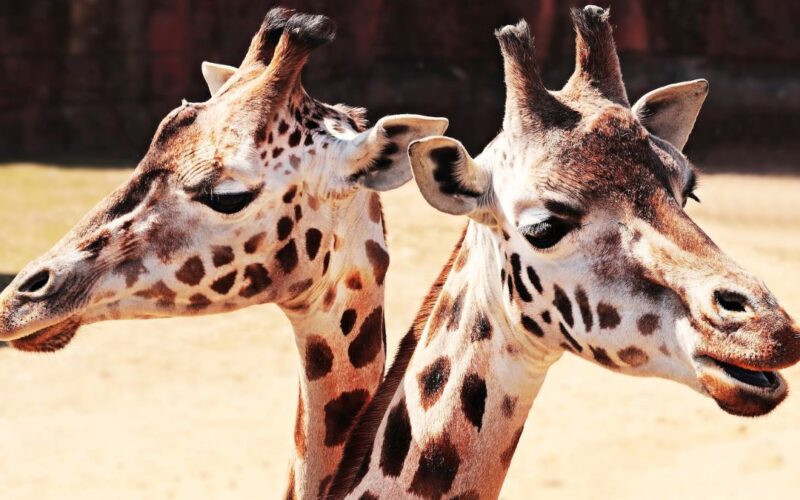In the vast landscapes of the African savanna, one creature stands out with its towering elegance – the giraffe (Giraffa camelopardalis). These gentle giants are not only the tallest land mammals but also possess unique characteristics that make them truly captivating. In this exploration, we delve into ten fascinating facts about giraffes, unraveling the mysteries of these majestic creatures that grace the iconic plains of Africa.
Extraordinary Height
Giraffes are renowned for their extraordinary height, standing as the tallest land mammals on Earth. Adult males, known as bulls, can reach heights of up to 18 feet (5.5 meters), while females, or cows, are slightly shorter. The distinctive long necks, which can extend up to six feet (1.8 meters), allow giraffes to reach high branches and foliage in their quest for food.
Distinctive Coat Patterns
The giraffe’s coat is adorned with distinctive irregular patches that resemble the outlines of puzzle pieces. These unique coat patterns, ranging in color from light tan to dark orange, serve as camouflage in the dappled sunlight of the savanna, helping giraffes blend seamlessly with their surroundings and evade potential predators.
Social Creatures
Contrary to their serene appearance, giraffes are social animals that thrive in groups known as towers or journeys. These groups typically consist of related females and their offspring. Giraffes engage in social interactions, such as necking (gentle sparring), which establishes dominance within the group and enhances social bonds.
Tongue Talents
Giraffes boast an impressive tongue that can extend up to 45 centimeters (18 inches). This remarkable organ aids them in foraging for leaves on tall trees. The prehensile tongue is not only long but also tough and flexible, allowing giraffes to navigate thorny branches without injury. Their blue-black tongues are thought to have evolved as a sunblock against the harsh African sun.
Giraffe Anatomy – Unique Vascular System
To pump blood to their lofty heads without fainting when bending down to drink water, giraffes possess a unique vascular system. Valves in the neck’s blood vessels regulate blood flow, preventing sudden rushes and maintaining a steady supply to the brain. This adaptation allows giraffes to perform the acrobatics required for both drinking and grazing.

Giraffe Gestation and Calves
Giraffes have a gestation period of about 15 months, one of the longest among mammals. Female giraffes give birth while standing, and the newborn calf drops to the ground from a height of about six feet (1.8 meters). Within a few hours, the calf is able to stand and walk, a crucial adaptation for survival in the wild.
Giraffe’s Natural Habitat
The natural habitat of giraffes includes savannas, grasslands, and open woodlands across sub-Saharan Africa. They are often found in regions with acacia and mimosa trees, which provide a significant portion of their diet. The ability to thrive in diverse habitats makes giraffes well-adapted to a range of environments on the continent.
Giraffe Conservation Challenges
Despite their iconic status, giraffes face conservation challenges. The International Union for Conservation of Nature (IUCN) lists giraffes as a species of “Least Concern,” but their populations have experienced declines in recent years due to habitat loss, poaching, and human-wildlife conflict. Conservation efforts are crucial to ensuring the survival of these magnificent creatures.
Giraffe Migratory Patterns
Giraffes are known to exhibit migratory patterns, covering large distances in search of food and water. Their movements are often influenced by seasonal changes and resource availability. The ability to migrate helps giraffes maintain a balance between their dietary needs and the ever-changing conditions of the African landscape.
Giraffes and Thorny Acacia Trees
Giraffes share a unique ecological relationship with thorny acacia trees. While browsing on the leaves, giraffes stimulate the acacias to produce tannins, which are chemical compounds that make the leaves less palatable to other herbivores. This mutualistic interaction benefits both the giraffes, who enjoy a less competitive food source, and the acacias, which deter potential herbivore threats.
Giraffes, with their towering presence and distinctive features, are not just charismatic symbols of the African savanna but also essential components of the continent’s ecosystems. As we unravel the intricacies of their behavior, anatomy, and habitat, it becomes clear that the conservation of these gentle giants is a collective responsibility.










